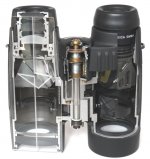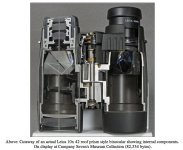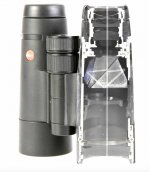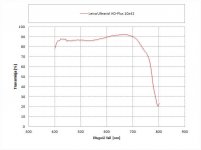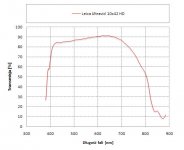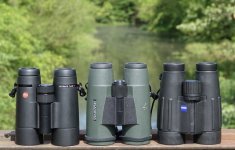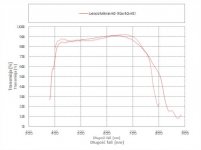John A Roberts
Well-known member

Dennis
Although I only addressed the 7x42’s . . .
Both the BA/ BN series and the Ultravid series were/ are offered in the same combinations: 8x32, 10x32, 7x42, 8x42, 10x42, 8x50, 10x50 and 12x50
And the respective models have the same number of lenses per side (from Leica’s catalogues):
- 8 for the 7x42 and 8x50
- 9 for 8x32, 8x42, 10x42 and 10x50
- 11 for the 10x32 and 12x50
In terms of working out what this means, the only cut-aways available are for x42 models (and irritatingly the same photos of BA units are variously described as 7, 8 or 10x42!
- as the portion of the left hand barrels that had the badge indicating the magnification have been removed, there’s no external indication of the magnification)
As far as I’ve been able to sort this out for the BA x42’s, only the eyepiece configurations seem to differ:
- 7x42, 4 elements in 3 groups: 1, 2, 1 (see the image in my previous post - it clearly has 8 lenses per side)
- 8x42, 5 elements in 3 groups: 2, 2, 1 (see below, from: https://pbase.com/g_hawkins/image/87929892 )
- 10x42, 5 elements in 3 groups: 2, 2, 1 (again see below, it’s from Company 7: http://www.company7.com/library/c7journal/leica_10x42cutaway.html )
While the 8x42’s and 10x42’s have the same number of eyepiece lenses in the same groupings, it's clear from the images that the lenses significantly differ in curvature, diameter and thickness
I’ve also attached an image of an Ultravid HD 8x42 cutaway from Foto HH (for other photos from them of Leica units see: https://www.ebay.com/sch/leica-stor...Ke4AAOSwu1VW2sT-&rt=nc&_trksid=p2047675.l2562 )
What’s significant, is that while the configuration of the eyepiece lenses/ groups is the same as for the BA counterpart, the lenses visibly differ in some small details
(if for no other reason, this may have been necessitated by the changes to the eyepiece housing and the mounts for the lenses)
So it seems that between the BA and the UV HD lines there was some tweaking of the lenses - at least for the 8x42 - and one would suspect the same happened for the whole Ultravid line
John
Although I only addressed the 7x42’s . . .
Both the BA/ BN series and the Ultravid series were/ are offered in the same combinations: 8x32, 10x32, 7x42, 8x42, 10x42, 8x50, 10x50 and 12x50
And the respective models have the same number of lenses per side (from Leica’s catalogues):
- 8 for the 7x42 and 8x50
- 9 for 8x32, 8x42, 10x42 and 10x50
- 11 for the 10x32 and 12x50
In terms of working out what this means, the only cut-aways available are for x42 models (and irritatingly the same photos of BA units are variously described as 7, 8 or 10x42!
- as the portion of the left hand barrels that had the badge indicating the magnification have been removed, there’s no external indication of the magnification)
As far as I’ve been able to sort this out for the BA x42’s, only the eyepiece configurations seem to differ:
- 7x42, 4 elements in 3 groups: 1, 2, 1 (see the image in my previous post - it clearly has 8 lenses per side)
- 8x42, 5 elements in 3 groups: 2, 2, 1 (see below, from: https://pbase.com/g_hawkins/image/87929892 )
- 10x42, 5 elements in 3 groups: 2, 2, 1 (again see below, it’s from Company 7: http://www.company7.com/library/c7journal/leica_10x42cutaway.html )
While the 8x42’s and 10x42’s have the same number of eyepiece lenses in the same groupings, it's clear from the images that the lenses significantly differ in curvature, diameter and thickness
I’ve also attached an image of an Ultravid HD 8x42 cutaway from Foto HH (for other photos from them of Leica units see: https://www.ebay.com/sch/leica-stor...Ke4AAOSwu1VW2sT-&rt=nc&_trksid=p2047675.l2562 )
What’s significant, is that while the configuration of the eyepiece lenses/ groups is the same as for the BA counterpart, the lenses visibly differ in some small details
(if for no other reason, this may have been necessitated by the changes to the eyepiece housing and the mounts for the lenses)
So it seems that between the BA and the UV HD lines there was some tweaking of the lenses - at least for the 8x42 - and one would suspect the same happened for the whole Ultravid line
John
Attachments
Last edited:




